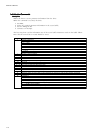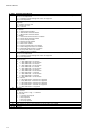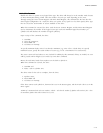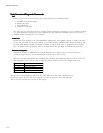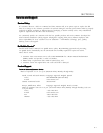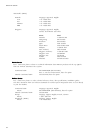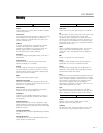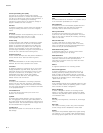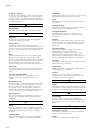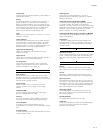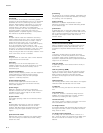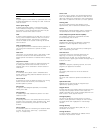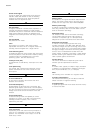
GLOSSARY
GL – 1
GLOSSARY
GlossaryGlossary
GlossaryGlossary
Glossary
AA
AA
A
access
To obtain data from, or place data into, RAM, a register,
or data storage device.
access time
The interval between the issuing of an access command
and the instant that the target data may be read or
written. Access time includes seek time, latency and
controller overhead time.
address
A number, generally binary, distinguishing a specific
member of an ordered set of locations. In disk
engineering, the address may consist of drives (unit
address), radial positions (cylinder address), or
circumferential position (sector address).
allocation
A process of assigning designated areas of the disk to
particular files.
alternate track
A spare track used in the event that a normal track
becomes damaged or is unusable.
analog
A signal or system that does not use digital states to
convey information. A signal may have any number of
significant states (values), contrasted to digital signals
which can only have two states.
ANSI
American National Standards Institute.
application program
A sequence of programmed instructions that tell the
computer how to perform some end-user task, such as
accounting or word processing.
areal density
Bit density (bits per inch) multiplied by track density
(tracks per inch) or bits per square inch.
asymmetry
A distortion of the readback signal which is shown in
different intervals between the positive and negative
voltage peaks.
auxiliary memory
Memory other than main memory; generally a mass-
storage subsystem containing disk drives and backup
tape drives, controller(s) and buffer memory (also called
peripheral memory).
average access time
The average time to make all possible length accesses
(seeks).
average seek time
The average time to make all possible length seeks. A
typical measure of performance.
BB
BB
B
bad block
A block that cannot store data because of a media flaw.
bit
An abbreviation for binary digit, of which there are two (0
and 1). A bit is the basic data unit of most digital
computers. A bit is usually part of a data byte or word,
but bits may be used singly to control or read logic “on-
off” functions. The fundamental unit information, often
used loosely to refer to a circuit or magnetization state at
a particular instant in time.
BIOS
Acronym for Basic Input/Output System. The firmware
area of a CPU that controls operations through the
system bus and to the attached cards and peripheral
devices.
BPI
Acronym for bits per inch. See bit density.
block
A group of bytes handled, stored, and accessed as a
logical data unit, such as an individual file record.
buffer
A temporary data storage area that compensates for a
difference in data transfer rates and/or data processing
rates between sender and receiver.
bus
A collection of functionally parallel conductors that forms
an interconnection between functional blocks in a digital
device. A length of parallel conductors that forms a major
interconnection route between the computer system
CPU (central processing unit) and its peripheral
subsystems. Depending on its design, a bus may carry
data, addresses, power, and more.
byte
An ordered collection of bits treated as a unit. Most
often, a byte is understood to consist of eight bits. One
byte is necessary to define an alphanumeric character.
CC
CC
C
cache
Random access memory (RAM) used as a buffer
between the CPU and the disk drive.
capacity
The amount of data, usually expressed in bytes, which
can be stored in a given device or portion of same.



